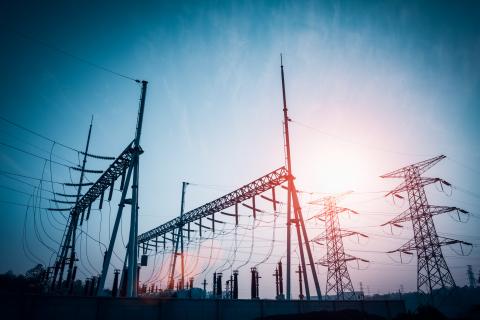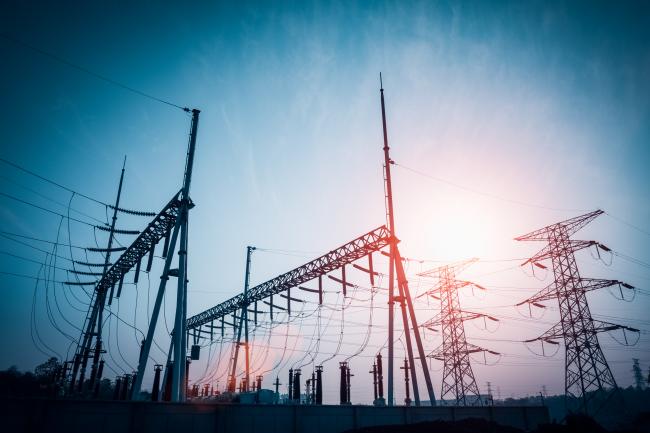Panel 1
Gabriele Bellabarba, Maria Logorelli
**The indicator reports, for each region/autonomous province and for different voltage levels, the kilometers of existing power lines, both in absolute terms and in relation to the territorial area.**
With regard to the structure of the national power grid, differentiated by voltage, the information is based on data provided by the ARPA/APPA and contained within the ISPRA CEM Observatory.
Between 2022 and 2023, a slight increase was observed in 40-150 kV power lines (+0.7%), while a decrease was noted in 220 kV (-5.9%) and 380 kV (-3.8%) power lines. The relative stability of 40-150 kV power lines indicates a positive trend for this type of electromagnetic source, as these lines often need to branch out in urban contexts where the population density is higher.
The variations recorded this year for 220 kV and 380 kV power lines are primarily attributed to improved data availability in the computerized systems developed in the regions that experienced significant changes compared to the previous year.
However, this type of electromagnetic source remains essential for providing all necessary services to the population. Nevertheless, existing lines have long been subject to intensive monitoring activities, supported by dedicated regulations specifically designed to protect the population from both short- and long-term effects caused by the electric and magnetic fields generated by high-voltage transmission lines.
The indicator reports, for each region/autonomous province and for different voltage levels, the kilometers of existing power lines, both in absolute terms and relative to the territorial area.
Quantifying the Main Sources of Environmental Pressure with Respect to Extremely Low Frequency (ELF) Fields.
Article 4 of Framework Law 36/2001 on the protection from exposure to electric, magnetic, and electromagnetic fields mandates the establishment of a national register (Catasto) of both fixed and mobile sources of electric, magnetic, and electromagnetic fields, as well as the territorial zones affected. It also requires the creation of regional registers, developed in coordination with the national register.
On February 13, 2014, the ministerial decree for the establishment of this register was issued, following a lengthy consultation process between ISPRA and the ARPA/APPA that began several years prior. This process aimed to define and share the technical specifications necessary for the creation of the register.
The National Electromagnetic Registry (CEN) operates in coordination with the various Regional Electromagnetic Registries (CER), and regional projects funded by MASE are currently being initiated in accordance with the provisions of DD n.72/2016 regarding the development and management of CERs.
This effort is expected to provide a significant boost to the full operationalization of these regional registries, and consequently, to the overall effectiveness of the CEN.
Panel 2
ISPRA, Annuario dei dati ambientali, various editions
ISPRA, Thematic Reports, various editions
Numerous challenges characterize the collection of information related to the facilities in question, including issues related to spatial and temporal coverage and data quality. Chief among these is the absence of a decree specifying the procedures for entering data into the National Electromagnetic Registry (CEN) for ELF sources.
Additional factors include the limited efficiency of local data collection tools, as well as a lack of dedicated human and financial resources for this activity.
Coordinated efforts by the involved stakeholders to support the flow of information through appropriate regulatory tools and targeted activities aimed at analyzing the aforementioned critical issues. The objective is to clarify existing challenges and propose solutions to ensure greater data uniformity and comprehensiveness at the national level.
Data quality assessment
Osservatorio CEM
ISTAT
9/20
2023
Indicator assessment
Line length count (km) and normalized ratio of these lines to regional surface area.
Considering the electric power lines with voltage levels of 40-150 kV, 220 kV, and 380 kV for the regions that provided updated data for 2023 (Piedmont, Aosta Valley, Lombardy, Veneto, Friuli-Venezia Giulia, Tuscany, Umbria, Molise, and Sicily), a territorial distribution of approximately 70%, 18%, and 12% respectively is observed with respect to the total length of power lines (Table 1).
Electric power lines with voltage levels of 40-150 kV, while emitting electric and magnetic fields of lower intensity compared to 220 kV and 380 kV lines, present greater challenges in terms of interaction with urban environments or nearby areas.
Their greater presence in the territory is due to the electrical characteristics of the line and the need to branch out into urban contexts.
Between 2022 and 2023, comparing the data for the regions that provided the necessary information (Piedmont, Aosta Valley, Lombardy, Veneto, Friuli-Venezia Giulia, Tuscany, and Sicily), a slight increase in 40-150 kV lines (+0.7%) is observed, along with a decrease in 220 kV lines (-5.9%) and 380 kV lines (-3.8%) (Table 2).
Data
Table 1: Length (L) of electric power lines, differentiated by voltage and region, in absolute values and normalized to regional surface area (S) (2023)
ISPRA analysis based on ARPA/APPA data (CEM Observatory), ISTAT (updated as of 01/01/2024)
a The Italy total refers to regions for which the data is complete and up-to-date,
b Data not updated,
c Line length normalized to regional surface area (km of line per 100 km² of territory),
nd: data not available,
\*: the data does not cover the entire region,
d Partial update, 2023 data received from Inrete Distribuzione and RFI,
e The data related to HV (Alta Tensione) and EHV (Altissima Tensione) power lines were acquired from Terna in 2021. However, the information request addressed to ENEL regarding medium-voltage (MV) power lines has not been fulfilled. The data related to 40-150 kV lines were provided solely by the provincial department of Salerno and refer to projects for the construction of renewable energy (FER) source installations.
Table 2: comparison of line length (L) of electric power lines, differentiated by voltage and region, in absolute values and normalized to regional surface area (S) for the years 2022 and 2023.
Elaboration by ISPRA on ARPA/APPA data (CEM Observatory), ISTAT (update as of 01/01/2024)
a The Italy total refers to regions for which the data is complete and up-to-date,
b Data not updated,
c Line length normalized to regional surface area (km of line per 100 km² of territory),
nd: data not available,
*: the data does not cover the entire region,
d Partial update, 2023 data received from Inrete Distribuzione and RFI,
e The data related to HV (High Voltage) and EHV (Extra High Voltage) power lines were acquired from Terna in 2021. The information request addressed to ENEL regarding medium-voltage (MV) power lines has not been fulfilled. The data related to 40-150 kV lines were provided solely by the provincial department of Salerno and refer to projects for the construction of renewable energy (FER) source installations.
For the year 2022, this note indicates the following: the data related to HV and EHV power lines were acquired from Terna in 2021; the data acquired from RFI and those derived from the "List of HV/MV sections of e-distribuzione for which an energy flow reversal was detected for at least 1% and 5% of the time in 2022" published by Enel in 2023.


The number of primary substations and secondary substations was not considered, as almost no region currently has this information available.
With regard to the composition of the national power grid, differentiated by voltage, the data presented in Table 1 are those provided by the ARPA/APPA and included in the ISPRA CEM Observatory.
The information has been updated by 9 regions (Piedmont, Aosta Valley, Lombardy, Veneto, Friuli-Venezia Giulia, Tuscany, Umbria, Molise, and Sicily).
The relative stability of 40-150 kV power lines indicates a positive trend for this type of electromagnetic source, as these lines often need to branch out into urban areas with higher population densities.
The variations observed this year for 220 kV and 380 kV power lines are mainly due to improved information available from the computerized systems developed in the regions that have experienced significant changes compared to the previous year.
However, this type of electromagnetic source is essential for adequately providing all necessary services to the population. Nevertheless, existing lines have long been subject to intensive monitoring activities, supported by dedicated regulations specifically designed to protect the population from both short- and long-term effects caused by the electric and magnetic fields generated by high-voltage transmission lines.